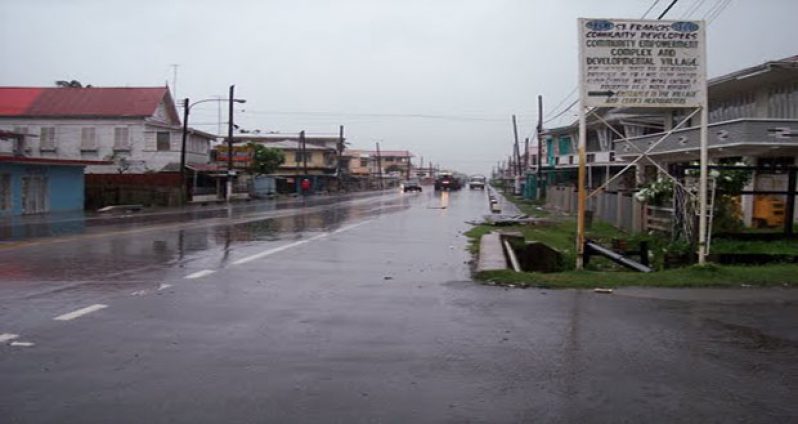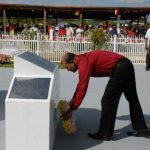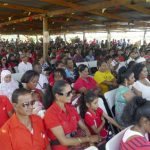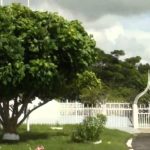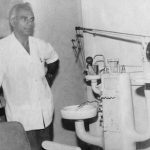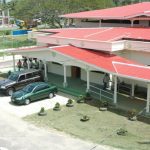– also the birth place of Guyana’s late iconic leader Dr. Cheddi Jagan
– and famous cricketers like Rohan Kanhai, Basil Butcher, Joe Solomon, Alvin Kallicharran, Randolph Ramnarace, Ivan Madray and John Trim
I WAS greatly anticipating my visit to this village, and folks, I certainly had good reason to do so. You see, I have always been told stories of what a wonderful location it is with its almost pristine beauty, old-world charm and the almost liquid rivulets of cheer and festivity that are present amongst its people.
So naturally when the opportunity came I was up and ready quite early, preening my face and selecting the best attire, since I certainly wanted to make an impression.
Still, I was in no way prepared for the whirlpool of laughter that engulfed me, coupled with the merry smiles and twinkling eyes that welcomed me on my arrival. There was such a high degree of welcoming warmth and hospitality that exuded from the people that in no time I was caught up in the heady tentacles of pleasant conversation, hearty giggles and even brotherly hugs in some cases.
This was certainly the place I wanted to be and I instantly decided to take every advantage of the occasion.
I was in the breathtaking village of Port Mourant in Corentyne, Berbice.
A LITTLE HISTORY
Port Mourant is a village located in Region 6 (East Berbice/Corentyne), in Guyana. This agriculturally sustained village is famous for producing one of the country’s most influential and iconic political figures, Dr. Cheddi Jagan.
Dr. Jagan and many of his contemporaries from Port Mourant who later excelled, were fortunate to attend the first and very successful secondary school established in the village by the academic – Pandit RN Persaud. This village has also produced a number of famous cricketers, for example, Rohan Kanhai, Basil Butcher, Joe Solomon, Alvin Kallicharran, Randolph Ramnarace, Ivan Madray and John Trim.
In addition, one of the world famous attorneys Sir Lionel Luckhoo was born in Port Mourant. There are a number of families who have migrated from Port Mourant to the United States and Canada and have become very successful and outstanding citizens, such as the Mohans, Persauds, Narines, Tiwaris, Bahadurs, Deepoos, Babolaals, Chesters, Drepauls, Deonarines, Etwarus, Mangrus, Prasads, Awatars, Ramrattans, Burchells, Rostums and Ramtejs, and the list goes on and on.
At latitude 6.2500 longitude – 57.3333, Port Mourant stands on average about three feet above sea level. To the west of its border is located Guyana’s smallest town, Rose Hall, and to the east lies Bloomfield. To the north and south the village is bordered by the Atlantic Ocean and sugar cane fields respectively.
It is a very large village made up of about 15 settlements including Free Yard, Bound Yard, Portuguese Quarter, Bangladesh, Ankerville, Clifton, Tain, Miss Phoebe and John’s, and it is nestled between Guyana’s smallest town of Rose Hall to the west and Bloomfield Village to the east. Bound Yard got its name from the indentured labourers who lived there. After they had served their contracts they moved to another location, suitably called Free Yard.
CRICKET GREATS
Census report figures from the Guyana Bureau of Statistics indicate that the settlement’s population in 2002 was 7,570. As history would dictate, many international “cricket greats” such as Rohan Kanhai, Basil Butcher, Joe Solomon, Randolph Ramnarace, Ivan Madray, the Etwaroo brothers and brothers Alvin Kallicharran & Derek Kallicharran, have earned their cricketing berth here in Miss Phoebe.
EDUCATION FROM ‘NURSERY TO UNIVERSITY’
Port Mourant was also described as the only village that offers education from “Nursery to University.” This community has quite rightfully attained fame as being a location that is rich in diversified educative talent and certainly creates a positive forum where youths can come to grips with the evolving hands of time and of course be assured of educative fulfilment.
And it’s quite refreshing to know that our youths are allowed choices in this arena with the availability of intellectual institutions like Tain, Ankerville and Port Mourant Nursery, Tain Primary School, Joseph Chamberlain Chandisingh Secondary School (formerly Corentyne High School, Est.1938), Port Mourant Primary School and Secondary Schools, and of course there is also the Corentyne Comprehensive High School.
One would also want to mention the Guyana Business School (Private) – closed as of 2013, the GuySuCo Apprentice Training Centre, and certainly the University of Guyana – Tain Campus.
To bring tertiary education to rural areas in Guyana, an extension of the university’s Georgetown campus was erected in Tain, Berbice. This branch of the institution was opened to the public in November 2000.
But even though there are so many schools in the village, there are also cases of children not attending. Some are also said to be involved in drugs and alcohol abuse, and engage in petty theft and fights as stated by some villagers.
GBTI
The Guyana Bank for Trade and Industry Limited (GBTI) Port Mourant branch offers Berbicians a drive-in facility for large deposits and Saturday openings to coincide with market shopping.
The branch, which is housed in the lower flat of a privately owned building was transformed at a cost of some $50 million. It was found that renovating and renting were better options than spending over $200 million on a new building.
It was the second to be launched in East Berbice and the 12th in the country. It also offers adequate parking and a distinctive style of banking and convenience to customers.
Customers can also access their accounts from the comfort of their homes or offices. GBTI has also upgraded its core banking software.
ALLURING SIMPLICITY
I was quite awed by the beauty of Port Mourant with its rolling landscapes, colourful houses all mystically infused in an impressive array of commercial business, quaint little shops and quite a few historical structures that took me to the days of colonial rule.
Wondering what it was like in years gone by, I was directed to the elderly Pulmattie Sookdeo who painted a vivid picture of thatched-roof houses, gurgling drains, open fields and rich, agricultural prospects.
In her distinct ‘creole’ dialect, she said:
“In me time as wan lil gal we used tuh runabout naked skin all ovah de place without a care in the world. De place nah bin suh nice like nowadays but it was always pleasant and breezy as usual. Every wan was in a jab. Nuff ah dem bin a wuk ah suga estate while some would sell them cash crops from de farms in the backlands. De market place was always busy with dem vendas shouting ah de tap ah dem vice fuh people come buy dem items. Dis place bin always nice and really pleasant, and today it even nicah. We get nuff schools, banks and business, and we glad how Govament ah develop de place.”
Today this location is being transformed into a social landscape incorporating people from various ethnic and cultural backgrounds.
I truly enjoyed trekking through the sandy dams, well managed access roads that entwined together various sections of the village. And it was a distinct pleasure to mingle with the people and listen to their many colourful tales. I truly admired that enticing manner in which the little colourful houses were nestled close to each other and the striking manner in which commercial business transformed the area into a thriving economic hub.
CHATTING WITH THE PEOPLE
Sheila Ramsaroop, describing Port Mourant as a very productive and developing area, was high in praise of the fact that the People’s Progressive Party (PPP) Government had made possible employment opportunities and many avenues for meaningful earning.
She was also high in praise of the fact that the village has now acquired a new and spacious market, banks have been erected, a training centre from which youth can benefit and of course the hospital, and other amenities.
“We have our own market, commercial banks, schools, and a training centre for youths, gas station; we even have our own hospital. I am indeed grateful that the Government has looked into these areas of our welfare.”
We stopped to chat briefly with a mason, Philip Trotman, and he was happy for the transformation the village has taken on over the years.
“In years gone by, this village was showing great signs of economic growth and I am glad that Government has taken strides in earmarking and developing this area. With all the development that has occurred here now, we are looking quite nice and development is moving ahead rapidly.”
School teacher Sharmilah Thakur was certainly proud of her hometown and did not “mince matters” in applauding efforts by Government to develop and upgrade the location.
“I have been living here for over 15 years and during that time I have seen quite a lot done in terms of development by the Government in many sectors. Yes, indeed it will take a while for the Government to tackle all the problems in every sector of this beautiful Guyana, but if one chooses to be honest they would shed light on the facts that many villages are benefiting in the areas of new roads, potable water, electricity, recreational facilities, upgraded education and so much more. In our village too this is very evident and we are very happy that the present Government is doing all in its power to take Guyana a notch higher. It will not all happen overnight, since everything takes time. But we are moving ahead at a steady pace and I would definitely like to applaud the present Government for their efforts and commitment to develop this country…”
SALUTING TWO GREATS
Many of our most influential citizens have originated from this village and it will be certainly insulting if we do not shed light, albeit briefly, on the likes, aspirations and exploits of two of the greats sons from Port Mourant.
• Dr. Cheddi Jagan
The year was 1918, when on March 22, in the rural village of Port Mourant in Guyana, the remarkable life of an ordinary sugar worker’s son began. His name was Cheddi Jagan, and before his time was over he would change the course of his country’s history by first struggling to liberate it from British colonial domination, then by waging a 28 year long struggle for the restoration of freedom and democracy, and finally by ascending to the Presidency as Guyana’s first democratically elected Head of State.
Alongside Dr. Jagan in all these struggles was his American born wife, lifelong friend and political partner, Janet, who left the USA for life in Guyana where she remained until her death on March 28, 2009. She was a woman of a number of firsts in her long history of involvement in her adopted country’s politics. She was to reach the pinnacle as first woman Head of State in December 1997, following the death in office of her husband on March 6, after first serving as Prime Minister.
They were the founders of the country’s first mass political movement and unquestionably the leading political figures in the history of Guyana for over the last 66 years. Through their tireless efforts, the small country of Guyana experienced a wealth of benefits, social advancement and economic prosperity.
As international figures they are well known for their fight for peace and freedom around the globe. Dr. Jagan’s ideas on debt relief, as well as his proposals for a New Global Human Order, were adopted by the United Nations General Assembly on November 14, 2002. As such, he deserves credit as a major figure in modern history.
Port Mourant has been home to many scholars and elites of society and amongst them is Sir Lionel Alfred Luckhoo, whose name still remains on the tongues of many natives.
Sir Lionel Alfred Luckhoo, KCMG, CBE, Q.C. (March 2, 1914 – December 12, 1997) was a Guyana-born politician, diplomat, and well-known lawyer, famed for his 245 consecutive successful defences in murder cases.
Luckhoo’s grandfather, Moses Luckhoo, was one of many Indians brought to Guyana as indentured labourers in the sugar industry in the mid-19th century. In 1899, Sir Lionel’s father, Edward Alfred Luckhoo, became the first Indian solicitor of Guyana.
Luckhoo was born in New Amsterdam, British Guiana, and was one of three sons and two daughters born into a prominent family of lawyers. His mother was Evelyn Maude Mungal-Singh, and his sisters were Ena Luckhoo and Renee Luckhoo. His two brothers, Edward Victor Luckhoo and Claude Lloyd Luckhoo, became Queen’s Counsels.
He was educated at Queen’s College, Georgetown. Then he began studying medicine at St. Thomas’ Hospital in England, but quickly felt squeamish about surgical procedures. He shifted over to legal studies and was called to the English Bar in the Middle Temple in 1940. At the same time that Allied troops were evacuating Dunkirk in World War II, Luckhoo left England for his homeland. He entered into a solicitor’s practice with one of his brothers in the firm, Luckhoo and Luckhoo.
He maintained his private legal practice spanning most of the years from 1940 to 1985, and became a Queen’s Counsel in 1954. His reputation earned him an entry in the Guinness Book of Records (1990) in which he is dubbed the world’s “most successful lawyer”. The record is for obtaining, as a defence trial lawyer, 245 successive murder acquittals. In a few instances, his clients were found guilty in jury trials, but were acquitted in appeal cases. He also practised as a barrister in England and later served as a judge of the Supreme Court of Guyana.
He also came to notoriety as the legal personal representative of the Reverend Jim Jones. Jones was the founder and leader of the People’s Temple Church, and had left California in the 1970s to establish a commune in Guyana known as ‘Jonestown’.
HEALTH CARE
With focus on the welfare and health of residents, Government has made possible the still impressive Port Mourant Hospital – A 53-bed facility located in Ankerville, with primary health care, paediatrics, and minor surgical services are provided to patients, cost- free.
The National Ophthalmology Centre was launched on July 25, 2009, providing services for Guyana and neighbouring country Suriname. That aside, there is the Guysuco Dispensary at Side Line Dam, and the Port Mourant Community Centre, famous for being the home of the Port Mourant Cricket Club.
PORT MOURANT & TAIN MARKETS
These two locations bustle with activity and serve as a rich melting pot of possibilities, where residents and outsiders can obtain practically any kitchen or household supplies.
At Port Mourant, a seven-day-a-week market which has become one of the largest market places in the country on Saturdays, attracting both buyers and sellers from many parts of the country. This is primarily a farmers’ market but a wide variety of groceries and clothing goods could also be purchased here.
On the other hand at Tain, the market serves primarily Tain, Johns, Clifton and Miss Phoebe settlements. Tain market allows local farmers a site to market their produce. However, due to the dwindling number of farmers in these areas, the popularity of the market has, over the years, diminished somewhat, according to residents.
As early as 02:00hrs on any day, vendors put on a few layers of clothing to keep their bodies warm as they hustle off to their respective vehicles to grab several sacks of green vegetables and stack them in a corner where wholesalers are eagerly waiting to buy off the supplies.
Dubbed the largest marketplace in the country, the Port Mourant Market has afforded many parents the opportunity of sending their children to school, with some even studying abroad before returning to serve their homeland.
What seems to be popular in this market location is the ‘Bend Down Boutique’ which offers used clothing and other items (normally acquired from overseas) to residents at great discount prices or on special bargain arrangements.
The ‘Bend Down Boutique’, as it is commonly called, is an open area where vendors, drawn from as far as Georgetown and Suriname, take various used items to sell, ranging from clothing, bed sheets, curtains and shoes, along with canned foodstuff, among other items. The items, which are sold off cheaply, attract persons from all strata of the society.
Some vendors amidst sheepish giggles shared that while some are seen going through the various bundles of clothing just after daybreak, others prefer to do their shopping when it is still dark, not wanting persons to see what they are purchasing.
One must certainly mention the Babu John Cemetery, famous as being the location of the cremation of Dr. Cheddi Jagan and his wife Janet Jagan.
RELIGION
The primary religions in this area of Guyana as with most of Guyana are, Hinduism, Christianity and Islam.
And such persons worship at Miss Phoebe North Kali Temple, Free Yard Hindu Mandir, Shri Krishna Mandir (Miss Phoebe north), Vishnu Saanaatan Mandir, Maha Kali Mandir (Portuguese quarter north), and the God of the Change International Church Haswell.
On the platter also are the Miss Phoebe Hindu Mandir, Sideline Shiva Mandir, Tain Bible Church, Tain Living Water Assembly, Tain Seven Day Adventist, Tain Hindu Mandir, St. Joseph Anglican Church and St Francis Xavier Roman Catholic Church
CINEMA
Roopmahal Cinema in Miss Phoebe is one of the oldest cinemas in the Berbice area.
The cinema has been closed for over five years, because people in the area are buying TVs, and not patronising the theatre. Also, many stayed away from the cinema at night due to safety concerns as some villagers indicated. The cinema was eventually torn down and a huge mall was built in its place on October 9, 2013.
NATIONAL OPHTHALMOLOGY HOSPITAL
Villagers during my visit to this lovely village rained praises on the Government for making possible the National Ophthalmology Hospital, which has been meeting their health needs and taking healthcare a notch higher in the area.
Since the hospital began screening on February 9 for various eye ailments including cataract and pterygium, over 4000 screenings have been done, according to reports.
According to reports, when the institution was opened, there was a shortlist generated from screening done at the other health institutions; over 352 persons have been identified for surgeries; 94 for cataract, 252 for pterygium and six for laser surgery. The Ministry of Health had also introduced the low-cost spectacle programme at the Ophthalmology Hospital and over 200 spectacles were distributed.
Other Guyanese are also benefiting from this programme, as it has been made available at the Georgetown Public Hospital Corporation, and the West Demerara, Diamond and Linden Hospitals.
The National Ophthalmology hospital will be providing an entire range of services. This institution is expected to conduct 10,000 eye surgeries per year and will even cater for persons from neighbouring countries.
AMENITIES
Residents of Port Mourant continue to praise the present Government for ensuring a reliable supply of potable water supply, electricity, a telephone service and good roads in the community.
Persons can relax and unwind at several popular hangout spots, and get their kitchen supplies from Spready’s and Paul Singh’s Bakeries.
That aside, there are fast-food outlets, a supermarket, small restaurants, rum shops, a gas station, travel service, a barber’s shop, lumber yard, Skye Communication, E-Networks and various other businesses. The village also has a turf club which attracts a lot of fans to horse-racing events, which is one of the major forms of entertainment.
SHELTERS
The Canaan Home for homeless children can also be found in the village. The Arya Samaj Humanitarian Mission has established an empowerment centre, where vulnerable persons could be trained, as well as a shelter for homeless persons. Nearby, the Guyana Hindu Dharmic Sabha has also constructed a children’s shelter.
Most of the residents are self-employed, while some have jobs in and out of the area, including at the Albion Estate as labourers and cane-harvesters.
CONCLUSION
This village is quite a bellyful of pleasant suprises coupled with jolly people of all races. And I must say folks, as I left the location and headed for the city of Georgetown, it dawned upon me that a part of me was definitely left behind.
I will return there instantly at the beckoning of practically anyone…This was quite an experience!


.jpg)




